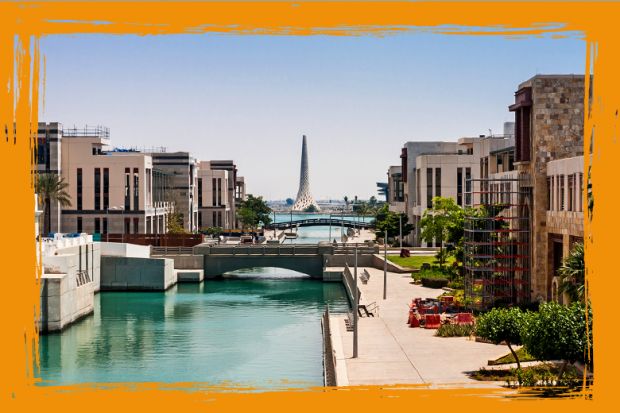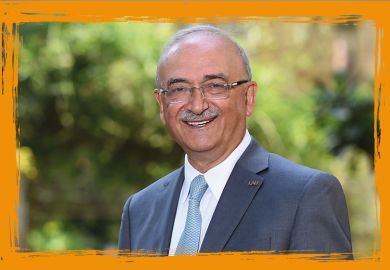Browse the full results of the Arab University Rankings 2023
A new frontrunner has emerged to lead the Times Higher Education Arab University Rankings this year. King Abdullah University of Science and Technology (KAUST) in Saudi Arabia has moved up from second place last year to take the top spot.
Saudi Arabia also dominates the top 10, with five universities ranking in this group, while the United Arab Emirates takes four places. The UAE’s Khalifa University climbs up three places to rank second.
KAUST scores a perfect 100 for research environment, one of only two universities among the 207 ranked to do so (the other is Qatar University, which ranks third overall). Meanwhile, its scores in the society pillar (measuring industry income, as well as participation and performance in the Impact Rankings) and the international outlook pillar (measuring the share of international students, staff and co-authorship, as well as research collaboration within the Arab world) have improved since last year.
Arab University Rankings 2023: a region of resilience and growth
Arab University Rankings 2023: UAE leads on collaboration
Is the Gulf the new heart of academia in the Middle East?
Talking leadership: Michel Mawad on riding out the storm in Lebanon
Pierre Magistretti, vice-president for research at the Saudi Arabian institution, attributed the strong research performance to being “closely aligned” with the kingdom’s targets for the emerging economy.
“From basic research, through early-stage applied research, to late-stage applied research, everything we do is designed to support economic progress in Saudi Arabia in line with the kingdom’s Vision 2030,” he said.
The move by the government to set up the Research, Development and Innovation Authority in June 2021, which works in a similar way to the US National Science Foundation and the European Research Commission, had also solidified funding, according to Professor Magistretti.
Meanwhile, local issues, such as the need for sustainable water desalination and the challenge of agriculture in a harsh desert environment, provided “fertile ground” for applied research, he added.
Abdellatif Sellami, director of the educational research centre at Qatar University, said that Saudi Arabia had succeeded in opening new universities, with the initial target to provide literacy. However, it had since moved on to using higher education to provide a knowledge economy as part of nation building.
Although the top of the Arab rankings table is dominated by institutions in the Persian Gulf, Egypt has the highest representation in the top 100, with 25 universities, although this is four fewer than last year.
Dr Sellami distinguished a country such as Egypt from the Gulf nations, highlighting their different demographics, education models and instruction languages.
He said Egypt had a population of more than 100 million, but countries such as Qatar had figures of about 3 per cent of that, he said.
Teaching at AI-focused university adapts as advances are made
NYU Abu Dhabi head: we’re ready to lead thinking on SDGs
Talking leadership: Ahmad Dallal is educator first, administrator second
Arab University Rankings 2023 digital edition
Furthermore, with branch campuses aplenty, the American model of education “runs supreme” in the Gulf nations, said Dr Sellami (replacing the British model that used to be more prominent). In contrast, North African countries such as Egypt, Morocco, Jordan and Tunisia were shaped “by the legacy of past colonialism” and, as a result, they had leaned towards French, Dutch and Belgian models of education.
However, inspired by the success of Singaporean and Chinese universities, Gulf countries were now looking to the East for their models, according to Dr Sellami, a shift that he said he considered “unprecedented”. Models of assessment, curricula and modes of teaching were among the elements that they were looking to emulate, he added.
With a growing disparity between the top-ranking institutions in the Gulf and the older institutions in other parts of the Middle East, Dr Sellami said, a key issue was that of language of instruction. National, traditional universities were continuing to teach in Arabic, while the newer international and private universities had adopted English.
As a result, the research capability of traditional universities had taken a hit too, the scholar said. Publishing in English involved the option of “hundreds of journals with impact and, therefore, visibility,” he explained. Research in Arabic, by contrast, which was not indexed on international databases, missed out on that “impact factor".
tiya.alexander@timeshighereducation.com
Arab University Rankings 2023: top 10
| Arab rank 2023 | Arab rank 2022 | Institution | Country |
| 1 | 2 | King Abdullah University of Science and Technology (KAUST) | Saudi Arabia |
| 2 | 5 | Khalifa University | United Arab Emirates |
| 3 | 3 | Qatar University | Qatar |
| =4 | 6 | King Fahd University of Petroleum and Minerals | Saudi Arabia |
| =4 | 9 | University of Sharjah | United Arab Emirates |
| 6 | 25 | King Khalid University | Saudi Arabia |
| 7 | =7 | United Arab Emirates University | United Arab Emirates |
| 8 | 4 | Prince Mohammad Bin Fahd University | Saudi Arabia |
| 9 | 39 | Abu Dhabi University | United Arab Emirates |
| 10 | =7 | King Saud University | Saudi Arabia |
Note: some changes to institutions’ scores will be influenced by methodological changes this year and we would advise noting that when making comparisons with previous years’ results.
Register to continue
Why register?
- Registration is free and only takes a moment
- Once registered, you can read 3 articles a month
- Sign up for our newsletter
Subscribe
Or subscribe for unlimited access to:
- Unlimited access to news, views, insights & reviews
- Digital editions
- Digital access to THE’s university and college rankings analysis
Already registered or a current subscriber? Login








